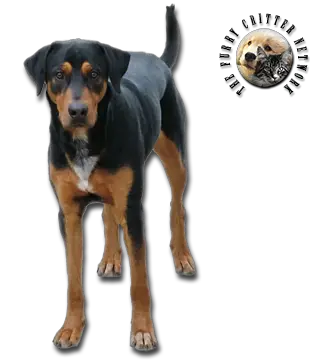Breed Standard
Head: Fairly long. Slightly domed skull. Stop not pronounced. Straight nosebridge. Tight-lipped.
Ears: Hanging without wrinkles, wider in the center, rounded tips.
Eyes: Medium-sized, oval, slightly slanted, dark brown.
Body: Nearly square. Muscular neck of medium length. Pronounced withers. Long, broad chest. Slight tuck-up.
Tail: Set on low. Hanging at rest. Curled level with the topline in action.
Hair: Short-legged variety: short, straight, dense hair. - Long-legged variety: longer, denser, harsher hair. Undercoat.
Coat: Short-legged variety: reddish-brown toward the abdomen and legs. - Long-legged variety: black. Red spots on the eyebrows, muzzle, and legs. Both varieties often have white spots on the forehead, chest, feet, and tip of the tail.
Size:
- Short-legged variety: 45 to 50 cm (17,7-19,7 in).
- Long-legged variety: 55 to 65 cm (21,7-25,6 in).
Weight: 30 to 35 kg (66-77 lb).
History
The Transylvanian Hound originated in the ninth century, when the Magyars brought in hounds and crossed them with local breeds and Polish hounds. He was used in hunting wolf and bear and comes in two varieties:- Short-legged, used on fox and hare; and - Long legged, specializing in wild boar, deer, and lynx.
Behavior
The breed is extremely loyal and friendly. They are very good natured and well mannered with both people and other dogs. They form strong attachments to their owners and are very protective of family members. It is very protective of its immediate territory (i.e. owners' house and yard), and will appear very ferocious with an intimidating bark and growl towards strangers; however, it will immediately accept anyone who is invited into the area by its owners. They enjoy constant companionship and tend to remain in the presence of their owners. They have an excellent sense of direction.
He needs lots of exercise and regular brushing.
Function
Hunting Dog, Companion Dog.
Health
No known hereditary health problems.






